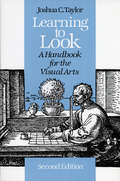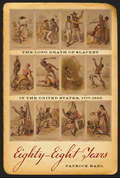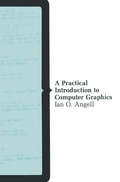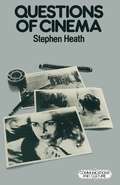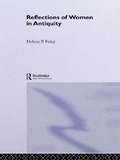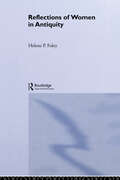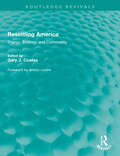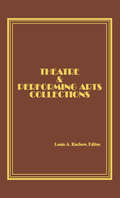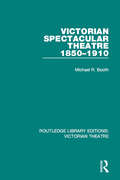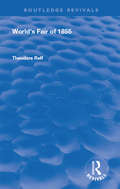- Table View
- List View
Learning to Look: A Handbook for the Visual Arts
by Joshua C. TaylorSometimes seeing is more difficult for the student of art than believing. Taylor, in a book that has sold more than 300,000 copies since its original publication in 1957, has helped two generations of art students "learn to look." This handy guide to the visual arts is designed to provide a comprehensive view of art, moving from the analytic study of specific works to a consideration of broad principles and technical matters. Forty-four carefully selected illustrations afford an excellent sampling of the wide range of experience awaiting the explorer. The second edition of Learning to Look includes a new chapter on twentieth-century art. Taylor's thoughtful discussion of pure forms and our responses to them gives the reader a few useful starting points for looking at art that does not reproduce nature and for understanding the distance between contemporary figurative art and reality.
Learning to Look: A Handbook for the Visual Arts
by Joshua C. TaylorSometimes seeing is more difficult for the student of art than believing. Taylor, in a book that has sold more than 300,000 copies since its original publication in 1957, has helped two generations of art students "learn to look." This handy guide to the visual arts is designed to provide a comprehensive view of art, moving from the analytic study of specific works to a consideration of broad principles and technical matters. Forty-four carefully selected illustrations afford an excellent sampling of the wide range of experience awaiting the explorer. The second edition of Learning to Look includes a new chapter on twentieth-century art. Taylor's thoughtful discussion of pure forms and our responses to them gives the reader a few useful starting points for looking at art that does not reproduce nature and for understanding the distance between contemporary figurative art and reality.
Materials for Learning: How to Teach Adults at a Distance (Routledge Library Editions: Broadcasting #26)
by Janet JenkinsMaterials for Learning (1981) examines the ability of books and broadcasts to change lives. The combination of print, radio, television and group meetings – distance teaching – can transform education in developing countries. Effective distance teaching requires effective teaching materials, and up to now there has been a lack of guidance about how to produce such materials and how to do so for different cultures. Materials for Learning aims to supply this need by suggesting guidelines for action and, where evidence is mixed or lacking, defining questions that still require answers. It is a practical book aimed at people actively involved in nonformal education and will be particularly useful for the developing world educators. The book looks first at how distance teaching can help with educational problems, considers how adults learn, and surveys problems of language and culture. It then considers the planning of distance teaching and looks in detail at the use of different media. There were also chapters on teaching numeracy and science at a distance, and a discussion of the kind of support that can be provided for people studying at a distance.
Materials for Learning: How to Teach Adults at a Distance (Routledge Library Editions: Broadcasting #26)
by Janet JenkinsMaterials for Learning (1981) examines the ability of books and broadcasts to change lives. The combination of print, radio, television and group meetings – distance teaching – can transform education in developing countries. Effective distance teaching requires effective teaching materials, and up to now there has been a lack of guidance about how to produce such materials and how to do so for different cultures. Materials for Learning aims to supply this need by suggesting guidelines for action and, where evidence is mixed or lacking, defining questions that still require answers. It is a practical book aimed at people actively involved in nonformal education and will be particularly useful for the developing world educators. The book looks first at how distance teaching can help with educational problems, considers how adults learn, and surveys problems of language and culture. It then considers the planning of distance teaching and looks in detail at the use of different media. There were also chapters on teaching numeracy and science at a distance, and a discussion of the kind of support that can be provided for people studying at a distance.
Modelle und Strukturen: DAGM Symposium Hamburg, 6.–8. Oktober 1981 (Informatik-Fachberichte #49)
by B. RadigParsonages: Improvisation And The Theatre (Shire Library #786)
by Kate TillerFrom the middle ages to the present day the houses of local clergy – parsonages, vicarages and rectories – have been among the most significant buildings in parishes throughout England. Architecturally some of the best and most fully documented domestic buildings, their history is that of the small and medium sized house, from medieval vernacular to the bespoke designs of leading Victorian architects and the more modest homes of today's clergy. The lives lived in the parsonage, factual and fictional (from Austen to Trollope and the televised struggles of 'Rev' in London's East End in the 2010s) reveal not just a building, but a hub of spiritual and secular activity, at the heart of local life and linking it to wider, national history. In this engaging introduction, Kate Tiller brings together the architectural and social histories of the parsonage, drawing on the evidence of buildings, archival and literary accounts, and contemporary and modern images, to depict parsonages, their occupants and how their histories may be traced.
Pattern Analysis (Springer Series in Information Sciences #4)
by H. NiemannThis book is devoted to pattern analysis, that is, the automatic construc tion of a symbolic description for a complex pattern, like an image or con nected speech. Pattern analysis thus tries to simulate certain capabilities which go without saying in any human central nervous system. The increasing interest and growing efforts at solving the problems related with pattern analysis are motivated by the challenge of the problem and the expected ap plications. Potential applications are numerous and result from the fact that data can be gathered and stored by modern devices in ever increasing extent, thus making the finding of particular interesting facts or events in these hosts of data an ever increasing problem. It was tried to organize the book around one particular view of pattern analysis: the view that pattern analysis requires an appropriate set of modules operating on a common data base which contains interme processing diate results of processing. Although other views are certainly possible, this one was adopted because the author feels that it is a useful idea, be cause the size of this book had to be kept within reasonable bounds, and because it facilitated the composition of fairly self-contained chapters.
Planning in the Soviet Union (Routledge Revivals)
by Judith Pallot Denis J. ShawOriginally published in 1981 and based on the authors’ own research, this book provides a comprehensive review of planning in the Soviet Union up until the early 1980s for both geographers and Soviet specialists. Planning was particularly important in the Soviet Union since not only most spatial change, but all economic planning was the product of a systematic socio-political ideology. Planning was therefore the key to understanding the Soviet economy, society and spatial change. When it was first published, this was the first study in which the focus had been directed specifically at spatial planning in the Soviet Union in any systematic way.
Planning in the Soviet Union (Routledge Revivals)
by Judith Pallot Denis J. ShawOriginally published in 1981 and based on the authors’ own research, this book provides a comprehensive review of planning in the Soviet Union up until the early 1980s for both geographers and Soviet specialists. Planning was particularly important in the Soviet Union since not only most spatial change, but all economic planning was the product of a systematic socio-political ideology. Planning was therefore the key to understanding the Soviet economy, society and spatial change. When it was first published, this was the first study in which the focus had been directed specifically at spatial planning in the Soviet Union in any systematic way.
A Practical Introduction to Computer Graphics (Computers And Their Applications Ser.)
by Ian O. AngellReflections of Women in Antiquity
by Helene FoleyPublished in the year 1981, Reflections of Women in Antiquity is a valuable contribution to the field of Performance.
Reflections of Women in Antiquity
by Helene FoleyPublished in the year 1981, Reflections of Women in Antiquity is a valuable contribution to the field of Performance.
Resettling America: Energy, Ecology and Community (Routledge Revivals)
Every movement has its bellweathers, the ideas that lead the way and rally its adherents towards a set of shared values and visions. Resettling America was one such beacon – a publication for its time and ahead of its time. Those of us doing the work of sustainability and the transformation of communities feel grateful for Gary’s early and prescient contribution that has shaped the thinking of so many around the US and beyond. Essential reading for all green warriors! Jason F. McLennan, Chief Sustainability Officer – Perkins & Will. Founder, Living Building Challenge. Originally published in 1981 and now reissued with a new Preface by Gary J. Coates, Resettling America was one of the first comprehensive, transdisciplinary books on the crisis of sustainability and the implications of that crisis for the re-design of buildings, towns, cities and regions. Through essays by Coates, which provide a theory of ecological design, and case studies written by leading authors and activists of the time, the book presents a strategic vision of how it would be possible to create a sustainable and livable society through a process of cooperative community development rooted in a radical re-visioning of nature, self and society. By providing a strategic vision, as well offering practical means for creating a sustainable society worth sustaining, Resettling America remains more relevant and inspiring than ever to those who face the ecology of crises that now surround us in the 21st Century.
Resettling America: Energy, Ecology and Community (Routledge Revivals)
by Gary J. CoatesEvery movement has its bellweathers, the ideas that lead the way and rally its adherents towards a set of shared values and visions. Resettling America was one such beacon – a publication for its time and ahead of its time. Those of us doing the work of sustainability and the transformation of communities feel grateful for Gary’s early and prescient contribution that has shaped the thinking of so many around the US and beyond. Essential reading for all green warriors! Jason F. McLennan, Chief Sustainability Officer – Perkins & Will. Founder, Living Building Challenge. Originally published in 1981 and now reissued with a new Preface by Gary J. Coates, Resettling America was one of the first comprehensive, transdisciplinary books on the crisis of sustainability and the implications of that crisis for the re-design of buildings, towns, cities and regions. Through essays by Coates, which provide a theory of ecological design, and case studies written by leading authors and activists of the time, the book presents a strategic vision of how it would be possible to create a sustainable and livable society through a process of cooperative community development rooted in a radical re-visioning of nature, self and society. By providing a strategic vision, as well offering practical means for creating a sustainable society worth sustaining, Resettling America remains more relevant and inspiring than ever to those who face the ecology of crises that now surround us in the 21st Century.
Theatre and Performing Arts Collections
by Lee AshHere is an exciting book that provides detailed descriptions of dozens of the most important and unique collections of “theatricana” in the United States and Canada. In Theatre and Performing Arts Collections, distinguished theatre specialists, librarians, and curators describe the unique possessions of the best and largest collections in theatre and performing arts. Each chapter provides detailed descriptions of the collections, as well as important notes about their history--information that is not available in any other source!
Theatre and Performing Arts Collections
by Lee AshHere is an exciting book that provides detailed descriptions of dozens of the most important and unique collections of “theatricana” in the United States and Canada. In Theatre and Performing Arts Collections, distinguished theatre specialists, librarians, and curators describe the unique possessions of the best and largest collections in theatre and performing arts. Each chapter provides detailed descriptions of the collections, as well as important notes about their history--information that is not available in any other source!
Victorian Spectacular Theatre 1850-1910 (Routledge Library Editions: Victorian Theatre)
by Michael R. BoothOriginally published in 1981. This study concentrates on one aspect of Victorian theatre production in the second half of the nineteenth century – the spectacular, which came to dominate certain kinds of production during that period. A remarkably consistent style, it was used for a variety of dramatic forms, although surrounded by critical controversy. The book considers the theories and practice of spectacle production as well as the cultural and artistic movements that created the favourable conditions in which spectacle could dominate such large areas of theatre for so many years. It also discusses the growth of spectacle and the taste of the public for it, examining the influence of painting, archaeology, history, and the trend towards realism in stage production. An explanation of the working of spectacle in Shakespeare, pantomime and melodrama is followed by detailed reconstructions of the spectacle productions of Irving’s Faust and Beerbohm Tree’s King Henry VIII.
Victorian Spectacular Theatre 1850-1910 (Routledge Library Editions: Victorian Theatre)
by Michael R. BoothOriginally published in 1981. This study concentrates on one aspect of Victorian theatre production in the second half of the nineteenth century – the spectacular, which came to dominate certain kinds of production during that period. A remarkably consistent style, it was used for a variety of dramatic forms, although surrounded by critical controversy. The book considers the theories and practice of spectacle production as well as the cultural and artistic movements that created the favourable conditions in which spectacle could dominate such large areas of theatre for so many years. It also discusses the growth of spectacle and the taste of the public for it, examining the influence of painting, archaeology, history, and the trend towards realism in stage production. An explanation of the working of spectacle in Shakespeare, pantomime and melodrama is followed by detailed reconstructions of the spectacle productions of Irving’s Faust and Beerbohm Tree’s King Henry VIII.
Who Cares?: Christianity and Modern Problems
by F. G. HerodOriginally published in 1981, Who Cares? Christianity and Modern Problems explores a wide range of social problems and how they relate to Christianity. The book covers a variety of topics, including family, poverty, money, race, work, war, leisure, government, sex and marriage, and religion. In each case, it draws connections to Christian teaching and reflects the facts and attitudes of the time in which it was written. Adopting a flexible approach to study, the chapters and subjects discussed can be read in any order. The book is also equipped with a selection of exam questions set by various examining boards at the time of original publication. Who Cares? Christianity and Modern Problems will appeal to those with an interest in social history, religious history, and education.
Who Cares?: Christianity and Modern Problems
by F. G. HerodOriginally published in 1981, Who Cares? Christianity and Modern Problems explores a wide range of social problems and how they relate to Christianity. The book covers a variety of topics, including family, poverty, money, race, work, war, leisure, government, sex and marriage, and religion. In each case, it draws connections to Christian teaching and reflects the facts and attitudes of the time in which it was written. Adopting a flexible approach to study, the chapters and subjects discussed can be read in any order. The book is also equipped with a selection of exam questions set by various examining boards at the time of original publication. Who Cares? Christianity and Modern Problems will appeal to those with an interest in social history, religious history, and education.
World's Fair of 1855 (Routledge Revivals)
by Theodore ReffPublished in 1981: This is two-hundred catalogues of the Major Exhibitions reproduced in facsimile in forty-seven volumes.
World's Fair of 1855 (Routledge Revivals)
by Theodore ReffPublished in 1981: This is two-hundred catalogues of the Major Exhibitions reproduced in facsimile in forty-seven volumes.
